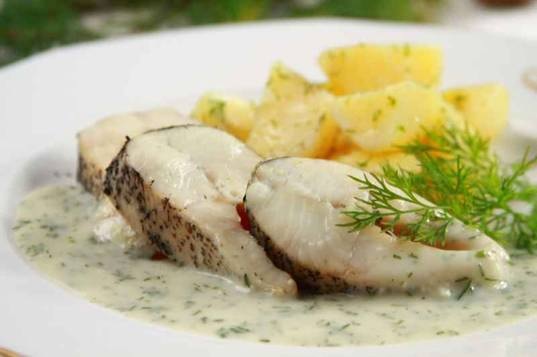Have you tried delicious Polish pike in a white sauce? Posted by Kasia on Oct 16, 2017 in Culture
This was always one of my favorite seafood dishes growing up in Poland. It was a delicacy, something special…Delicious! I actually caught few pikes myself as a child, and since pike (szczupak) has sharp teeth, all the kids always had to try first if it really bites…before it made it’s way to the plate:)
“Pike á la polonaise” was a delight which made old Polish cuisine famous in Europe. The recipe was cited in cookbooks of various countries between the 16th and 18th centuries, e.g. in the Czech “Kucharstvo”, in a German cookbook by Anna Wecker (end of the 16th century), and in the 17th century in French and Austrian cookbooks. The Polish character of the dish manifested itself with a hot flavour achieved by adding spices such as pepper, ginger, saffron, and nutmeg. Other ingredients, namely peas, croutons, onions and parsley root, were liquidized in order to prepare a thick, wine-based sauce.
In the times of the Enlightenment, Paul Tremo, court chef to King Stanisław August Poniatowski, developed a milder version of the dish. Its hot flavour was reduced by reducing the amount of spice in line with the governing Enlightenment rules. Another famous 17th-century recipe is pike served whole, which is even mentioned in “Pan Tadeusz”. As the pike was skewered on the horizontal spit of a rotisserie, liquid fat was poured over a part of it while another part of it was covered with a cloth on which vinegar was poured; the part that was to be roasted was treated with fat only at the very end.
The importance of pike in the Polish cuisine did not change in the subsequent centuries. The fish was first cooked in a stock made of spices and vegetables, or was roasted while being basted with liquid butter, and was finally dipped in horseradish sauce. Another popular method of serving pike was similar to that of serving carp, namely in grey sauce (made of lager beer or ale, with a bit of wine, fish blood and caramel, or rye bread) or in saffron sauce – a type of hollandaise sauce flavoured with this valuable spice. The fish was cooked without removing its scales, in salted water mixed with white wine.
“Since there is no platter big enough to serve the whole fish on, one has to serve it on a wooden board covered with a table cloth fixed to it, with the fish in a ‘standing’ position. Also, the board cannot be carried, so the sideboard attendant has to cut portions of fish and put them on plates, which are then delivered to each feaster.”
– explained Antoni Teslar in the 1910 edition of Polish and French Cuisine. Christmas pike could also be fried in cream, or served in aspic or as a roulade.
I enjoy this fish prepared all different ways! Definitely worth trying, if you never had it before:)

Build vocabulary, practice pronunciation, and more with Transparent Language Online. Available anytime, anywhere, on any device.





